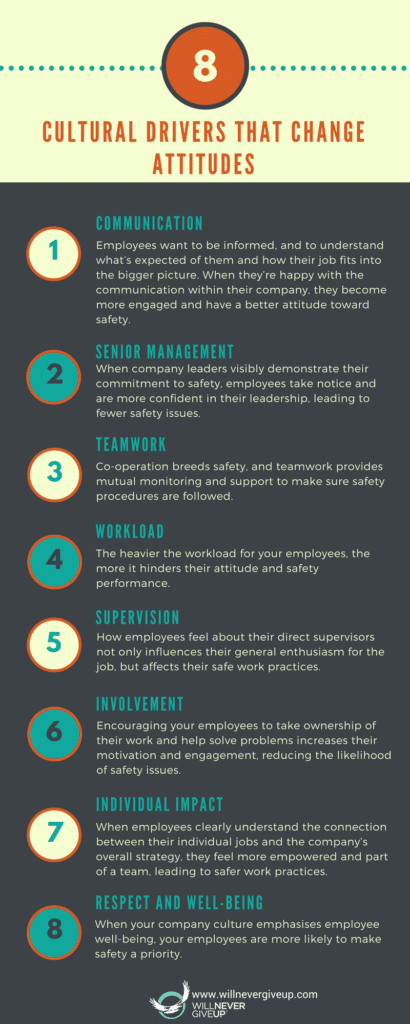In Part 2 of this series, “Mentoring for Positive Safety Attitudes”, I wrote about the valuable contribution of experienced workers when it comes to mentoring newer workers. So, does that mean that only the workers who have “been around the block a few times” can show effective safety leadership? Of course not.
It’s important to understand that communicating, co-operating, and leading, are skills that can be developed. We’re not born with those skills, although we may have acquired a basic understanding of working with others from childhood. As with everything, we go through an awkward learning stage while mastering these attitudes and skills. Eventually, the attitude of never giving up will defeat any awkwardness. Remember, nothing worthwhile is ever easy!
How can workers individually improve their attitude toward safety? The EHS Daily Advisor suggests that every employee can take positive steps to improve safety attitudes by:
- Being willing to learn about safety and health issues
- Complying with all safety regulations, rules, and procedures
- Taking personal responsibility for safety
- Focusing on and paying attention to tasks
- Keeping alert to and reporting hazards
- Participating in training and safety improvement
- Using required personal protective equipment (PPE) routinely
- Being concerned about and taking action to protect co-workers’ safety
- Avoiding risky behaviour
- Reporting accidents, near misses, and hazardous conditions
- Asking questions to learn more about safety and avoid mistakes that can lead to accidents
Once started, motivation to improve one’s attitude to safety will increase. There’s a reason – a million reasons – why it’s said that success breeds success. Progress might not be immediately evident, but over time the motivated worker will see how far they have come, and how their behaviours are being adopted by others.
Changes in workplace attitudes take time. Not everyone wants to help or be helped, and some need time and encouragement to alter their attitudes. Safety and attitudinal changes must be taken seriously in order to:
- Avoid accidents that can cause job-related injuries or other dangers
- Avoid exposure to hazardous substances that can lead to serious illness
- Comply with safety and health regulations
- Comply with company work rules, policies, and procedures
There is a strong relationship between employees’ opinions about their workplace culture and actual safety outcomes such as the number of accidents, days away from work, total recorded safety incidents, and workday interruptions. Cultures that emphasise employee well-being and production quality rather than just bottom-line numbers are more likely to make safety a top priority.
There are eight cultural drivers that change attitudes. While they seem simple, they are crucial for building company morale and motivating employees to own the safety process.

I have written before about attitude as ‘the spark that drives behaviour’. If positivity is the foundation of superior performance, it is imperative that organisations do all they can to foster a culture that rewards positive work attitudes.
This article originally published by INX Software, 31 July 2018.

Doug Wright is a transformed survivor of a head-on near-death vehicle collision. Passionate about helping people overcome their innermost fears, especially when recovering from trauma, Doug has survived to share his courageous story … his motto is “never give up”. Away from his everyday activities, Doug invests his spare time playing his electric guitar, knocking out an eclectic mix of Eagles hits and fishing for coral trout in Airlie Beach, Northern Queensland.


